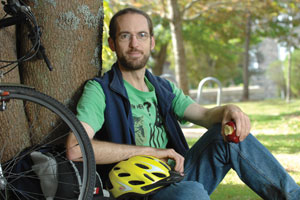 |
| Wayne Groszko. (Danny Abriel Photo) |
When Wayne Groszko talks about sustainability in the classroom, he doesn’t just rely on textbooks and lesson plans, or his scholarly background in oceanography. Instead, much of what he teaches his class of engineering students comes from his extensive personal and professional experience working to reduce environmental impacts.
His commitment to the cause runs so deeply through every facet of his life that he‚Äôs earned a reputation as one of ¬È∂π¥´√Ω‚Äôs most sustainable individuals.
“This has been central to my life since Grade Six,” he says, remembering his school days in a small town outside of Calgary. “I had a teacher named Mr. MacKinnon and he was all about pointing out how important the environment was at every opportunity. That really set the direction for me.”
An instructor in the Faculty of Engineering, Dr. Groszko is teaching Complementary Studies this term, a crash-course in environmental issues for engineering students that’s a requirement in most programs. It’s a broad survey, covering everything from climate change to air and water pollution. And a third of the class is dedicated to exploring engineering-related solutions, things such as wind and solar energy, sustainable transport planning and green building design.
In discussing the latter, Dr. Groszko draws heavily on his own experience renovating his 115-year-old home on Agricola Street,¬Ýdescribing in detail the work put into the re-insulating the entire home and replacing all of the siding and windows. The house was evaluated through the Energuide process, which rates the energy efficiency of a property out of 100. ‚ÄúWe started at 41 and now we‚Äôre at 72. We‚Äôre aiming for 82.‚Äù By this spring, he hopes to add a solar heating system that will provide heat and hot water, with the goal of also using solar for electricity afterwards.
The savings of all that work are significant – he expects to make up the net cost in nine years – but that’s not the real payoff. “The moment you finish it, you pay it off with the feeling that you’ve done something real to make a difference,” he says.
His commitment to sustainability doesn’t stop at housing. That Dr. Groszko lives within walking distance from campus is not a coincidence – he’s made a conscious choice to always live within an hour’s walk of anything he’d need on a daily basis. Most of the time, he bikes. And he’s a familiar face at the Halifax Farmer’s Market and smaller fresh markets around town, where he purchases most of his food. “It’s very important to me to have a direct relationship with where my food comes from.”
Put together, this profile of environmental commitment sounds not only impressive, but daunting. That’s why when he talks about making sustainable choices, Dr. Groszko encourages students to start with the small ones.
“I’d start what whatever it is that you’re interested in changing,” he says. “If you’re looking for the easiest change to make, it’s probably food, and it’s a very important one. Visit your farmer’s market, get to know the farmers and ask them questions. And even if you don’t live near a farmer’s market, most large grocery stores have started labeling local or organically-grown food. The best part is that food that’s local is less processed and brings more fruits and vegetables into your diet.”
“This isn’t a burden to me,” he adds. “I’m motivated by the same thing that’s always motivated me – the goal of living in a way that doesn’t destroy the natural world. It’s a way to fulfil my purpose in life.”
